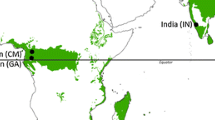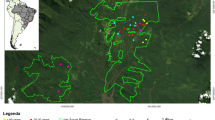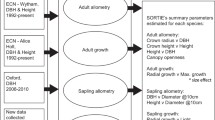Abstract
While theoretical allometric models postulate universal scaling exponents, empirical relationships between tree dimensions show marked variability that reflects changes in the biomass allocation pattern. As growth of the various tree compartments may be controlled by different functions, it is hypothesized that they may respond differently to factors of variation, resulting in variable tree morphologies and potentially in trade-offs between allometric relationships. We explore the variability of tree stem and crown allometries using a dataset of 1,729 trees located in an undisturbed wet evergreen forest of the Western Ghats, India. We specifically test whether species adult stature, terrain slope, tree size and crown light exposure affect the relationships between stem diameter and stem height (stem allometry), and between stem diameter and crown width, crown area and crown volume (crown allometries). Results show that both stem and crown allometries are subject to variations in relation to both endogenous (tree size, species adult stature) and exogenous (terrain slope, crown light exposure) factors. Stem allometry appears to be more affected by these factors than are crown allometries, including the stem diameter–crown volume relationship, which proved to be particularly stable. Our results support the idea that height is a prevailing adjustment factor for a tree facing variable growth (notably light) conditions, while stem diameter–crown volume allometry responds more to internal metabolic constraints. We ultimately discuss the various sources of variability in the stem and crown allometries of tropical trees that likely play an important role in forest community dynamics.



Similar content being viewed by others
References
Aiba SI, Kohyama T (1997) Crown architecture and life-history traits of 14 tree species in a warm-temperate rain forest: significance of spatial heterogeneity. J Ecol 85:611–624
Alder D, Synnott TJ (1992) Permanent sample plot techniques for mixed tropical forest. Tropical Forestry Papers 25, Oxford Forestry Institute, Oxford
Anten NPR, Schieving F (2010) The role of wood mass density and mechanical constraints in the economy of tree architecture. Am Nat 175:250–260
Ashton PS, Hall P (1992) Comparisons of structure among mixed dipterocarp forests of north-western Borneo. J Ecol 80:459–481
Banin L, Feldpausch TR, Phillips OL et al (2012) What controls tropical forest architecture? Testing environmental, structural and floristic drivers. Glob Ecol Biogeogr 21:1171–1190
Barthélémy D, Caraglio Y (2007) Plant architecture: a dynamic, multilevel and comprehensive approach to plant form, structure and ontogeny. Ann Bot 99:375–407
Bohlman S, O’Brien S (2006) Allometry, adult stature and regeneration requirement of 65 tree species on Barro Colorado Island, Panama. J Trop Ecol 22:123–136
Bohlman S, Pacala S (2012) A forest structure model that determines crown layers and partitions growth and mortality rates for landscape-scale applications of tropical forests. J Ecol 100:508–518
Brown JH, Gillooly JF, Allen AP, Savage VM, West GB (2004) Toward a metabolic theory of ecology. Ecology 85:1771–1789
Clark DB, Olivas PC, Oberbauer SF, Clark DA, Ryan MG (2008) First direct landscape-scale measurement of tropical rain forest Leaf Area Index, a key driver of global primary productivity. Ecol Lett 11(2):163–172
Coomes DA, Allen RB (2007) Mortality and tree-size distributions in natural mixed-age forests. J Ecol 95:27–40
Coomes DA, Allen RB (2009) Testing the metabolic scaling theory of tree growth. J Ecol 97:1369–1373
Coomes DA, Duncan RP, Allen RB, Truscott J (2003) Disturbances prevent stem size-density distributions in natural forests from following scaling relationships. Ecol Lett 6:980–989
Couteron P, Pélissier R, Nicolini EA, Paget D (2005) Predicting tropical forest stand structure parameters from Fourier transform of very high-resolution remotely sensed canopy images. J Appl Ecol 42:1121–1128
Cusset G (1980) Sur les paramètres intervenant dans la croissance des arbres: la relation hauteur-diamètre de l’axe primaire aérien. Candollea 35:231–255
Davies RB (1987) Hypothesis testing when a nuisance parameter is present only under the alternative. Biometrika 74:33–43
Falster DS, Westoby M (2005) Alternative height strategies among 45 dicot rain forest species from tropical Queensland, Australia. J Ecol 9:521–535
Feldpausch TR, Banin L, Phillips OL, Baker TR, Lewis SL et al (2011) Height-diameter allometry of tropical forest trees. Biogeosciences 8:1081–1106
Ferry B, Morneau F, Bontemps J, Blanc L, Freycon V (2010) Higher treefall rates on slopes and waterlogged soils result in lower stand biomass and productivity in a tropical rain forest. J Ecol 98:106–116
Fournier M, Stokes A, Coutand C, Fourcaud T, Moulia B (2006) Tree biomechanics and growth strategies in the context of forest functional ecology. In: Herrel A, Speck T, Rowe NP (eds) Ecology and biomechanics: a mechanical approach to the ecology of animals and plants. CRC Press, Boca Raton, pp 1–33
Gatsuk LE, Smirnova OV, Vorontzova LI, Zogolnova LB, Zhukova LA (1980) Age states of plants of various growth forms: a review. J Ecol 68:675–696
Gayon J (2000) History of the concept of allometry. Am Zool 40:748–758
Gilmore DW (2001) Equations to describe crown allometry of Larix require local validation. For Ecol Manag 148:109–116
Gimaret-Carpentier C, Pélissier R, Pascal J-P, Houllier F (1998) Sampling strategies for the assessment of tree species diversity. J Veg Sci 9:161–172
Hallé F, Oldeman RAA, Tomlinson PB (1978) Tropical trees and forests: an architectural analysis. Springer, Berlin
Harja D, Vincent G, Mulia R, van Noordwijk M (2012) Tree shape plasticity in relation to crown exposure. Trees 26:1275–1285
Heineman KD, Jensen E, Shapland A, Bogenrief B, Tan S, Rebarber R, Russo SE (2011) The effects of belowground resources on aboveground allometric growth in Bornean tree species. For Ecol Manag 261:1820–1832
Henry HAL, Aarssen LW (1999) The interpretation of stem diameter–height allometry in trees: biomechanical constraints, neighbour effects, or biased regressions? Ecol Lett 2:89–97
Iida Y, Kohyama TS, Kubo T, Kassim AR, Poorter L, Sterck F, Potts MD (2011) Tree architecture and life-history strategies across 200 co-occurring tropical tree species. Funct Ecol 25:1260–1268
Iida Y, Poorter L, Sterck FJ, Kassim AR, Kubo T, Potts MD, Kohyama TS (2012) Wood density explains architectural differentiation across 145 co-occurring tropical tree species. Funct Ecol 26:274–282
King DA (1990) Allometry of saplings and understorey trees of a Panamanian forest. Funct Ecol 4:27–32
King DA (1996) Allometry and life history of tropical trees. J Trop Ecol 12:25–44
King DA, Davies KF, Nur Supardi MN, Tan S (2005) Tree growth is related to light interception and wood density in two mixed dipterocarp forests of Malaysia. Funct Ecol 19:445–453
Kohyama T (1987) Significance of architecture and allometry in saplings. Funct Ecol 1:399–404
Kohyama T (1993) Size-structured tree population in gap-dynamic forest—the forest architecture hypothesis for the stable coexistence of species. J Ecol 81:131–143
Kohyama T, Suzuki E, Partomihardjo T, Yamada T, Kubo T (2003) Tree species differentiation in growth, recruitment and allometry in relation to maximum height in a Bornean mixed dipterocarp forest. J Ecol 91:797–806
Lang AC, Härdtle W, Bruelheide H, Geißler C, Nadrowski K, Schuldt A, Yu M, von Oheimb G (2010) Tree morphology responds to neighbourhood competition and slope in species-rich forests of subtropical China. For Ecol Manag 260:1708–1715
Lines ER, Zavala MA, Purves DW, Coomes DA (2012) Predictable changes in aboveground allometry of trees along gradients of temperature, aridity and competition. Glob Ecol Biogeogr 21:1017–1028
Loffeier ME (1989) Sylviculture et sylvigenese en foret sempervirente du Coorg (sud-ouest de l`Inde). Travaux de la section scientifique et technique, 26. French Institute of Pondicherry, India
Losos E, Leigh EG Jr (2004) Tropical forest diversity and dynamism—finding from a large-scale plot network. The University of Chicago Press, Chicago
Mascaro J, Asner GP, Muller-Landau HC, van Breugel M, Hall J, Dahlin K (2010) Controls over aboveground forest carbon density on Barro Colorado Island, Panama. Biogeosci Discuss 7:8817–8852
Moravie M-A, Durand M, Houllier F (1999) Ecological meaning and predictive ability of social status, vigour and competition indices in a tropical rain forest (India). For Ecol Manag 117:221–240
Muggeo VMR (2003) Estimating regression models with unknown break-points. Stat Med 22:3055–3071
Muggeo VMR (2008) Segmented: an R package to fit regression models with broken-line relationships. R News 8:20–25
Muller-Landau HC, Condit R, Chave J et al (2006) Testing metabolic ecology theory for allometric scaling of tree size, growth and mortality in tropical forests. Ecol Lett 9:575–588
Nogueira EM, Nelson BW, Fearnside PM, França MB, de Oliveira ACA (2008) Tree height in Brazil’s “arc of deforestation”: shorter trees in south and southwest Amazonia imply lower biomass. For Ecol Manag 255:2963–2972
Oldeman RAA (1974) L’architecture de la forêt guyanaise. Mémoires ORSTOM 73, Paris
Osada N, Tateno R, Hyodo F, Takeda H (2004) Changes in crown architecture with tree height in two deciduous tree species: developmental constraints or plastic response to the competition for light? For Ecol Manag 188:337–347
Paget D (1999) Etude de la diversité spatiale des écosystèmes forestiers guyanais. Réflexion méthodologique et application. PhD dissertation, Ecole Nationale de Génie Rural des Eaux et Forêts, Nancy, France
Pascal J-P (1984) Les forêts denses humides sempervirentes des Ghâts occidentaux de l’Inde : écologie, structure, floristique, succession. Travaux de la Section Scientifique et Technique 20, Institut Français de Pondichéry, Inde
Pascal J-P, Pélissier R (1996) Structure and floristic composition of a tropical evergreen forest in south-west India. J Trop Ecol 12:191–214
Pélissier R (1997) Hétérogénéité spatiale et dynamique d’une forêt dense humide dans les Ghâts occidentaux de l’Inde. Publications du Département d’Ecologie 37. Institut Français de Pondichéry, Inde
Pélissier R (1998) Tree spatial patterns in three contrasting plots of a southern Indian tropical moist evergreen forest. J Trop Ecol 14:1–16
Pélissier R, Pascal J-P, Ayyappan N, Ramesh BR, Aravajy S, Ramalingam SR (2011) Twenty years tree demography in an undisturbed dipterocarp Permanent Sample Plot at Uppangala, Western Ghats of India—Data Paper. Ecology 92:1376
Ploton P, Pélissier R, Proisy C, Flavenot T, Barbier N, Rai SN, Couteron P (2012) Assessing aboveground tropical forest biomass using Google Earth canopy images. Ecol Appl 22:993–1003
Poorter L, Bongers F, Sterck FJ, Wöll H (2003) Architecture of 53 rain forest tree species differing in adult stature and shade tolerance. Ecology 84:602–608
Poorter L, Bongers F, Sterck FJ, Wöll H (2005) Beyond the regeneration phase: differentiation of height-light trajectories among tropical tree species. J Ecol 93:256–267
Pretzsch H, Dieler J (2012) Evidence of variant intra- and interspecific scaling of tree crown structure and relevance for allometric theory. Oecologia 169:637–649
Proisy C, Barbier N, Guéroult M, Pélissier R, Gastellu-Etchegorry J-P, Couteron P (2012) Biomass prediction in tropical forests: the canopy grain approach. In: Fatoyinbo T (ed) Remote sensing of biomass: principles and applications. Book 1, Intech Open Access Publisher, Croatia, pp 59–76
R Development Core Team (2011) R: a language and environment for statistical computing. R Foundation for Statistical Computing, Vienna, Austria
Ramesh BR, Pascal J-P, Nouguier C (1997) Atlas of endemics of the Western Ghats (India): Distribution of tree species in the evergreen and semi-evergreen forest. Publications du Département d’Ecologie 38, Institut Français de Pondichéry, Inde
Robert A (2001) Modélisation de l’effet de la topographie sur la dynamique et la structure de peuplements forestiers hétérogènes. PhD dissertation, Laboratoire de Biométrie et Biologie Evolutive, Université Claude Bernard, Lyon, France
Robert A (2003) Simulation of the effect of topography and tree falls on stand dynamics and stand structure of tropical forests. Ecol Model 167:287–303
Robert A, Moravie M-A (2003) Topographic variation and stand heterogeneity in a wet evergreen forest of India. J Trop Ecol 19:697–707
Ruger N, Berger U, Hubbell SP, Vieilledent G, Condit R (2011) Growth strategies of tropical tree species: disentangling light and size effects. Plos One 6:e25330
Russell MB, Weiskittel AR (2011) Maximum and largest crown width equations for 15 tree species in Maine. North J Appl For 28:84–91
Russo SE, Wiser SK, Coomes DA (2007) Growth–size scaling relationships of woody plant species differ from predictions of the metabolic ecology model. Ecol Lett 10:889–901
Silveira AP, Martins FR, Araújo FS (2012) Are tree ontogenetic structure and allometric relationship independent of vegetation formation type? A case study with Cordia oncocalyx in the Brazilian caatinga. Acta Oecol 43:126–133
Sterck FJ, Bongers F (1998) Ontogenetic changes in size, allometry, and mechanical design of tropical rain forest trees. Am J Bot 85:266–272
Sterck FJ, Bongers F (2001) Crown development in tropical rain forest trees: patterns with tree height and light availability. J Ecol 89:1–13
Thomas SC (1996) Asymptotic height as a predictor of growth and allometric characteristics in Malaysian rain forest trees. Am J Bot 83:556–566
Umeki K (1995) Modeling the relationship between the asymmetry in crown display and local environment. Ecol Model 82:11–20
Venables WN, Ripley BD (2002) Modern applied statistics with S, 4th edn. Springer, New-York
Vincent G, Sabatier D, Blanc L, Chave J, Weissenbacher E, Pélissier R, Fonty E, Molino J-F, Couteron P (2012) Accuracy of small footprint airborne LiDAR in its predictions of tropical moist forest stand structure. Rem Sens Env 125:23–33
Vincent G, Caron F, Sabatier D, Blanc L (2013) LiDAR shows that higher forests have more slender trees. Bois Forêts Tropiques
Warton DI, Wright IJ, Falster DS, Westoby M (2006) Bivariate line-fitting methods for allometry. Biol Rev 81:259–291
Weiner J (2004) Allocation, plasticity and allometry in plants. Perspect Plant Ecol Evol Syst 6:207–215
West GB, Brown JH, Enquist BJ (1999) A general model for the structure and allometry of plant vascular systems. Nature 400:664–667
West GB, Enquist BJ, Brown JH (2009) A general quantitative theory of forest structure and dynamics. Proc Natl Acad Sci 106:7040–7045
Westoby M, Falster DS, Moles AT, Vesk PA, Wright IJ (2002) Plant ecological strategies: some leading dimensions of variation between species. Annu Rev Ecol Syst 33:125–159
Yamada T, Ngakan OP, Suzuki E (2005) Differences in growth trajectory and strategy of two sympatric congeneric species in an Indonesian floodplain forest. Am J Bot 92:45–52
Acknowledgments
UPSP is a permanent joint research station of the Karnataka Forest Department, Bangalore, and the French Institute of Pondicherry, India. We are very grateful to the many field workers, technicians, engineers and researchers who contributed to the plot’s long-term monitoring, and particularly to Jean-Pierre Pascal who settled the plot in 1990, to S. Ramalingam who took part in all field campaigns up to his retirement in 2011, and to the Gowda family from Uppangala village who are in charge of taking care of the plots. We’d also like to thank two anonymous reviewers of the journal, whose comments greatly helped us improving the manuscript. This study was conducted within the framework of a joint research project between UMR AMAP, France and NRSC (National Remote Sensing Centre), India, supported by IFPCAR (Indo-French Promotion Center for Advanced Research) through Grant 4409-C.
Author information
Authors and Affiliations
Corresponding author
Additional information
Communicated by T. Grams.
Electronic supplementary material
Below is the link to the electronic supplementary material.
Rights and permissions
About this article
Cite this article
Antin, C., Pélissier, R., Vincent, G. et al. Crown allometries are less responsive than stem allometry to tree size and habitat variations in an Indian monsoon forest. Trees 27, 1485–1495 (2013). https://doi.org/10.1007/s00468-013-0896-7
Received:
Revised:
Accepted:
Published:
Issue Date:
DOI: https://doi.org/10.1007/s00468-013-0896-7




